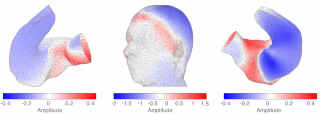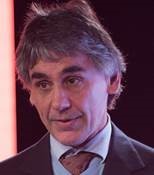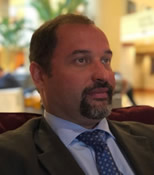
Kappel, Simon L. (2019-09-10). “Ear-EEG Forward Models: Improved Head-Models for Ear-EEG.” Frontiers in Neuroscience 13: 943. DOI:10.3389/ fnins.2019.00943. PMID 31551697. PMC: PMC6747017. ISSN 1662-453X.
 |
Claudio BabiloniWorking Group Leader Full Professor of Physiology |
 |
Fabrizio VecchioWorking Group Leader Researcher |
In 2018, the Executive Committee of the International Federation of Clinical Neurophysiology (IFCN) appointed Prof. Claudio Babiloni (Department of Physiology and Pharmacology “V. Erspamer”, Sapienza University of Rome, Italy) and Dr. Fabrizio Vecchio (Brain Connectivity Laboratory, IRCCS San Raffaele Pisana of Rome, Italy) to lead a newly established Special Interest Group (SIG) on Advanced EEG/MEG Techniques in Clinical Neurophysiology (AETCN). The SIG initially attracted approximately 100 international experts interested in advancing the definitions and procedures for EEG/MEG biomarkers in Clinical Neurophysiology.
Our SIG met to discuss the Review Manuscripts for Clinical Neurophysiology entitled "Alpha Rhythm and Alzheimer's Disease: Has Hans Berger's Dream Come True?" (October 25, 2024) Berger- Alzheimers Paper and was accepted in February 2025! It emphasizes the importance of Clinical Neurophysiology in Alzheimer’s disease on the unmet need for the use of EEG/MEG biomarkers in the assessment of patients with mild cognitive impairment and dementia within the pathophysiological dimension in Precision Medicine.
At the 31st International Congress of Clinical Neurophysiology (ICCN2018, Washington, DC, USA), held in Washington, DC (USA), from May 1–6, 2018, a dedicated SIG session explored key opportunities and controversies surrounding the application of EEG/MEG techniques to the study of brain functional connectivity. Prof. Claudio Babiloni opened the meeting by outlining major theoretical and methodological challenges. Presentations included: Prof. Mark Hallett on advances in corticomuscular connectivity in tremor; Prof. Pedro Valdés-Sosa on debates around defining EEG-MEG-derived functional connectivity, advocating for biologically grounded models; Prof. Mihaly Hajos on rodent EEG analysis for early-stage drug discovery; Prof. Stefan Rampp on EEG source connectivity for seizure localization; and Dr. Francesca Miraglia on the application of Graph Theory to brain network analysis in dementia.
At the 32nd ICCN (ICCN2022, Geneva, Switzerland) in Geneva, Switzerland (September 4–8, 2022), the SIG focused on the implications of the Delphi procedure's outcome—“European intersocietal recommendations for the biomarker-based diagnosis of neurocognitive disorders.” This consensus, developed by a multidisciplinary European task force (Frisoni et al., 2024), presented a diagnostic workflow for individuals with mild cognitive impairment (MCI) or mild-to-moderate dementia. While 11 clinical syndromes—including Alzheimer’s disease (AD)—were included, the use of EEG biomarkers was recommended only in cases suggesting late-onset epilepsy or autoimmune encephalopathy. The task force did not support the routine use of EEG in suspected AD when MRI and clinical findings were sufficient. In response, the SIG discussed and planned a position paper for Clinical Neurophysiology on the unmet need for EEG/MEG biomarkers in the pathophysiological dimension of Precision Medicine in MCI and dementia.
At the 33rd ICCN (ICCN2024, Jakarta, Indonesia) in Jakarta, Indonesia (September 10–14, 2024), the SIG reviewed and discussed draft chapters of the position paper titled “Alpha rhythm and Alzheimer's disease: Has Hans Berger's dream come true?” The manuscript revisited Hans Berger's groundbreaking discovery of human resting state electroencephalographic (rsEEG) alpha rhythms (8-12 Hz) in 1924, his foresight of substantial clinical applications in patients with “senile dementia,” and new developments in the field, focusing on AD, the most prevalent cause of dementia in pathological aging. It was reported that clinical guidelines issued in 2024 by the US National Institute on Aging-Alzheimer’s Association (NIA-AA; Jack et al., 2024) and the mentioned clinical guidelines of the European Neuroscience Societies (Frisoni et al., 2024) did not endorse routine use of rsEEG biomarkers in the clinical workup of older adults with cognitive impairment. Nevertheless, the expert panel highlighted decades of research from independent workgroups and different techniques showing consistent evidence that abnormalities in rsEEG delta, theta, and alpha rhythms (< 30 Hz) observed in AD patients correlate with well-established AD biomarkers of neuropathology, neurodegeneration, and cognitive decline. We posit that these abnormalities may reflect alterations in oscillatory synchronization within subcortical and cortical circuits, inducing cortical inhibitory-excitatory imbalance (in some cases leading to epileptiform activity) and vigilance dysfunctions (e.g., mental fatigue and drowsiness), which may impact AD patients’ quality of life. The manuscript was finalized, submitted to Clinical Neurophysiology in October 2024, accepted in January 2025, and published in April 2025.
Babiloni C, Arakaki X, Baez S, et al. Alpha rhythm and Alzheimer's disease: Has Hans Berger's dream come true? Clin Neurophysiol. 2025 Apr;172:33-50. doi: 10.1016/j.clinph.2025.02.256.
Jack CR, Andrews JS, Beach TG, Buracchio T, Dunn B, Graf A, et al. Revised criteria for diagnosis and staging of Alzheimer’s disease: Alzheimer’s Association Workgroup. Alzheimer’s & Dementia 2024;20:5143–69. https://doi.org/10.1002/alz.13859.